|
|
|
Sort Order |
|
|
|
Items / Page
|
|
|
|
|
|
|
| Srl | Item |
| 1 |
ID:
159026


|
|
|
|
|
| Summary/Abstract |
In this paper I study the behavior of money demand during the episode of hyperinflation that occurred in China after World War II. I consider two popular and competing money demand specifications – the log–log and the semi-log – and show that the log–log performs better than the semi-log in its ability to track the behavior of the money demand. The choice between the two specifications is of great importance, as it implies that welfare cost estimates are very different for hyperinflation. The findings also contribute to the understanding of Cagan’s paradox and the failure of Cagan inflationary finance models. The paradox might be attributable to the popular semi-log schedule for money demand, and the log–log schedule might be an appropriate form for the analysis of hyperinflation.
|
|
|
|
|
|
|
|
|
|
|
|
|
|
|
|
| 2 |
ID:
159023
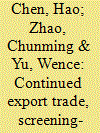

|
|
|
|
|
| Summary/Abstract |
The screening mechanism of export trade facilitates enterprises to increase their recruitment threshold, which in turn has a biased impact on the employment of heterogeneous individuals. Incorporating export trade, screening-matching and gender discrimination in employment into a unified analysis and applying propensity score matching estimation on the basis of the theoretical framework of micro-enterprise and the optimized behavior of job seekers, this paper examines the relations between export trade of industrial enterprises and female labor employment levels in China during 2005–2007. The results indicate that: (1) the number and ration of female employees are increasing with the size and growth of the enterprise export, regardless of enterprise exports continuity. It demonstrates that export expansion does play a critical role in mitigating gender discrimination in employment. (2) For the enterprise with higher export continuity, there is a significant effect toward improving the number and proportion of female employees, conversely the worse effect. Thus, it is significantly meaningful to mitigate gender discrimination in employment by ensuring the continued export capacity of enterprises. (3) Comparing to the promoting effect of growth in the number of female employees, export has limit effect up on increasing the proportion of female employees. Therefore, it is rather difficult to resolve the issue of gender discrimination in employment by relying completely on exports expansion. Based on research findings, this paper discusses the policy implications in terms of easing gender discrimination in employment and promoting employment equity.
|
|
|
|
|
|
|
|
|
|
|
|
|
|
|
|
| 3 |
ID:
159020
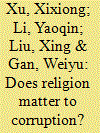

|
|
|
|
|
| Summary/Abstract |
There is a growing interest in understanding how religion affects corruption. Using provincial-level panel data from 1998 to 2009, this paper investigates the effect of religious beliefs on bureaucratic corruption in China. The empirical results show that, bureaucratic corruption is negatively associated with local religious heritage, implying that religious culture plays a positive role in restraining official's corruption since religion has influence on political preference and work ethic. We also find that the negative association between religion and corruption is weaker in provinces with stronger law enforcement, which identifies the substitution effect between religious ethic and legal supervision in curbing corruption. Our findings also reveal that, among the different religions, the anti-corruption effects of China's native religions (i.e., Taoism and Buddhism) are more significant than those of foreign religions (i.e., Christianity and Islam). These conclusions are consistent and robust to various measures of main variables and a variety of robustness checks. Given the very few studies and limited data resources in the context of China, this paper as a tentative study provides new evidences of the relationship between religion and corruption.
|
|
|
|
|
|
|
|
|
|
|
|
|
|
|
|
| 4 |
ID:
159025


|
|
|
|
|
| Summary/Abstract |
The paper studies the levels and changes in wage inequality among Chinese rural-urban migrants during 2002–2007. Using data from two waves of national household surveys, we find that wage inequality among migrants decreased significantly between 2002 and 2007. Our analysis on the wage distribution further shows that the high-wage migrants experienced slower wage growth than middle- and low-wage migrants—a primary cause of declining inequality of migrants. By using distributional decomposition methods based on quantile regression, we find that an overall between-group effect dominates in the whole wage distribution, which means that the change in returns to the characteristics (education, experience and other employment characteristics) plays a key role, but on the upper tails of the wage distribution, the within group effect (residual effect) dominates, implying that the unobservable factors or institutional barriers do not favor the migrants at the top tail of the wage distribution. We also study wage differential between migrants and urban natives, and find that though the wage gap is narrowed, the gap at the upper wage distribution is becoming bigger. Overall, the results suggest that there exists a strong “glass ceiling” for migrants in the urban labor market.
|
|
|
|
|
|
|
|
|
|
|
|
|
|
|
|
| 5 |
ID:
159022


|
|
|
|
|
| Summary/Abstract |
The “global slack hypothesis” implies that greater integration of the world economy, i.e. globalisation, should have made inflation more responsive to global than domestic economic slack. Many previous studies have accordingly estimated national inflation equations with measures of global output gaps. We use three and a half decades of subnational data from China's provinces to test the global slack hypothesis. Using tests for non-nested regressions, for many provinces we can reject a Phillips curve with a province-level measure of economic slack against a model with China's national output gap, which is consistent with the hypothesis. We also show that the real exchange rate matters for inflation dynamics in many Chinese provinces, in particular those most open to international trade. In addition to supporting the global slack hypothesis, our results emphasise the importance of cross-border factors for China's inflation developments.
|
|
|
|
|
|
|
|
|
|
|
|
|
|
|
|
| 6 |
ID:
159024


|
|
|
|
|
| Summary/Abstract |
Most analyses explain the increase in China's overall inequality during the reform period principally by means of the expansion of urban-rural income gap. This paper tries to state a relationship between functional distribution of income and China's Gini index. After presenting the main theoretical contributions that clarify the general relationship among those variables, we describe the mechanism that has connected them during the last decades in the Chinese economy. There exists a link between falling wage share, rising urban households' top incomes, urban-rural income gap and the Gini coefficient. These relationships are analysed for both the pre and post-crisis periods. After estimating the main relationships, the paper ends with a discussion on the ability of potential redistributive policies to reverse this pattern of inequality.
|
|
|
|
|
|
|
|
|
|
|
|
|
|
|
|
| 7 |
ID:
159018
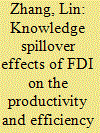

|
|
|
|
|
| Summary/Abstract |
As China is moving toward an innovation-driven economy, this paper offers new insights for both policymakers and investors to optimize the effectiveness of investment performance. This paper studies China's provincial research activities with a focus on the spillover-induced productivity and efficiency change. The results show that spillovers as a result of inflow of foreign investment contribute positively to the performance of overall research activities, however, the productivity effects vary across regions. Our analysis also indicates that highly skewed distribution of FDI leads to a less improved innovation efficiency in FDI-rich provinces. Future innovation policy should adjust the investment profiles based on the preferential innovation output on one hand, and optimize the complementary policy for FDI on the other hand to reduce inefficiency and the potential negative effects of knowledge spillovers. Inter-provincial governmental cooperation is necessary to resolve the uneven distribution of FDI and improve the innovation efficiency in both FDI-poor and rich regions.
|
|
|
|
|
|
|
|
|
|
|
|
|
|
|
|
| 8 |
ID:
159019
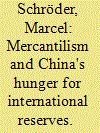

|
|
|
|
|
| Summary/Abstract |
This paper is motivated by the popular view that the surge in China's foreign exchange reserves is due to a distortionary exchange rate policy aimed at keeping the real exchange rate undervalued to support export-led growth. It undertakes an in-depth empirical investigation to quantify how much “mercantilist” and “precautionary” motives have contributed to the reserve build-up in China during 1998Q4-2011Q4. A substantial problem is that theory is consistent with employing two vastly differing approaches to defining and estimating the role of mercantilist reserve accumulation. A priori, either method could generate misleading results. The study shows, however, that the distinction between the two approaches is immaterial in China's case. The results suggest that mercantilism accounts for less than 10% of reserve accumulation. Precautionary motives and other factors seem to be the dominant determinants of the surge in China's international reserves.
|
|
|
|
|
|
|
|
|
|
|
|
|
|
|
|
| 9 |
ID:
159027
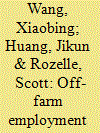

|
|
|
|
|
| Summary/Abstract |
While it is well known that China's off farm labor market is emerging rapidly, less is known about the effect of movement off the farm on the farming practices of those that have continued to farm. The overall goal of this paper is to analyze the effects of changes in China's off farm employment on one aspect of the performance of China's agricultural sector: the emergence of specialization in farming. To achieve this goal, we have three specific objectives. First, we document the changes in the flow of labor out of China's villages. Second, we examine how specialization in farming has changed over time. Third, we examine the association between off farm labor flows and specialization. Using panel data from a national representative data collected by the authors between 1999 and 2008, the analysis finds that off farm employment is indeed rising rapidly. At the same time, specialization is occurring off and on the farm. There is a strong and robust correlation between off farm employment and on farm specialization. The results imply that China's agriculture has responded dynamically to the modernization happening elsewhere in the economy.
|
|
|
|
|
|
|
|
|
|
|
|
|
|
|
|
| 10 |
ID:
159021


|
|
|
|
|
| Summary/Abstract |
This paper analyzes how strategic calibration of utility model patent regimes – which provide a type of patent right that is distinct from invention patents and is far less studied in the literature – over time is intended to facilitate technological development. To do this, the paper develops what appear to be the first indexes of utility model patent regime “strength” (divided into “strictness” and “appropriability” indexes), which it tabulates for mainland China, Japan, South Korea, and Taiwan per every year from the time of inception of their laws governing utility models (the first of which was in 1905) till 2016. It then analyzes these indexes via fixed effects regressions and case studies. The results show that East Asian latecomers instituted utility model patent regimes that were less strict and offered less appropriability during earlier stages of economic catch-up, likely in order to facilitate technological learning. Subsequently, the strictness of the regimes was increased as knowledge accumulation and, to some extent, technological capabilities increased and, in mainland China's case especially, as patent quality problems were experienced. It is also found that increasing the strictness of utility model patent regimes may reduce patenting in the short-term, but not the long-term. Six propositions are formulated, including the overall conclusion that successful latecomers seem to have pursued a dynamic catch-up strategy of transitioning from imitative to more sophisticated technological development by increasing both the strictness and appropriability-strength of their utility model patent regimes in conjunction with increasing knowledge accumulation and, to some extent, technological capabilities. It is suggested that mainland China might benefit from further increasing the strictness of its utility model patent regime in the future.
|
|
|
|
|
|
|
|
|
|
|
|
|
|
|
|
|
|
|
|
|